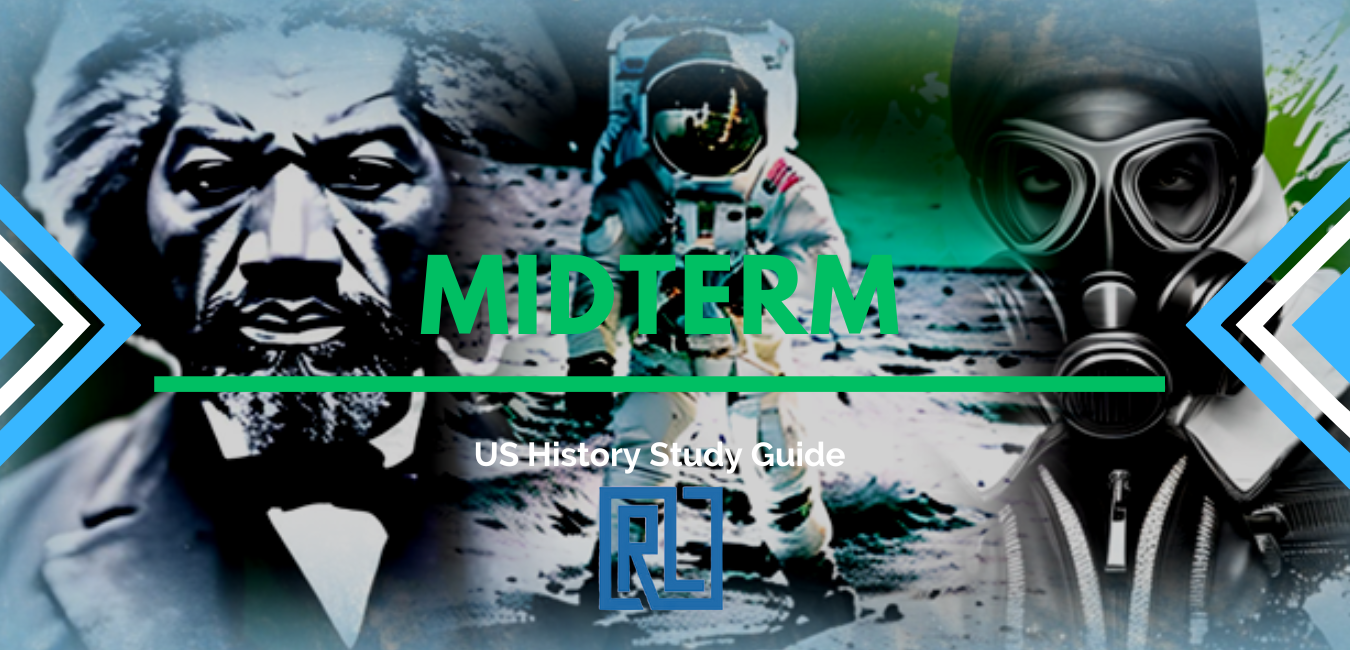|
"STUDY GUIDE" FOR THE US HISTORY PART TWO MIDTERM
"You ain't got much, but it's all you got!" College classrooms can be like an unruly beast, overflowing with information and causing you some serious heartburn. And boy, do I know the pain of a professor who declares, "the whole shebang is fair game for the midterm/final." That's why I whipped up this page for you, so you can take a more surgical approach to your studying. As far as the mechanics of the midterm:
Transcontinental Railroad and Industrialization
So, in the 1880s, America was going through some significant changes. They finished building a railroad that stretched across the country, which was a big deal for trading. And factories were popping up left and right, making many rich folks richer. Meanwhile, many European people were moving to America, making cities grow and more diverse. And people were finding new ways to have fun, like watching people do silly stuff on stage or playing organized sports. Politically, things were getting a little wild, with old parties splitting up and new ones popping up. They also passed some laws, like trying to make Native Americans act more like everyone else and trying to keep those big corporations from getting too powerful. IN OTHER WORDS: In the 1880s, America experienced significant changes including the completion of a transcontinental railroad, the emergence of new factories, increased immigration from Europe, the development of new forms of entertainment, and political turbulence as old parties split and new ones emerged, with laws being passed to assimilate Native Americans and limit the power of large corporations. Social and Cultural Changes in the United States during the 1890s In the late 1800s, the United States was a hotbed of change and conflict. Rapid industrialization and urbanization were transforming the country, but various groups were vying for power and influence, leading to political and economic tensions. Amidst this turmoil, the arts were flourishing, with modernism emerging as a prominent movement. Exploring this era provides valuable insight into the forces that have shaped American society and the challenges we face today. IN OTHER WORDS: In the late 1800s, the United States underwent rapid industrialization and urbanization, resulting in political and economic tensions, while modernism emerged as a prominent artistic movement. World War I and the United States The early 20th century was a time of major industrial and urban growth in the United States, which had significant social, economic, and political implications. Movements such as the Progressive Movement, suffrage, and civil rights for African Americans marked the period and provide insight into the values and priorities of Americans at the time. Additionally, global events like World War I and the emergence of the United States as a global power played a significant role in shaping the country's foreign policy and place in the world. By studying this time period, we can gain a deeper understanding of the forces that shaped the country and inform our understanding of the United States today. IN OTHER WORDS: The early 20th century saw significant industrial and urban growth in the United States, as well as social, economic, and political movements such as Progressivism, suffrage, and civil rights for African Americans, while global events such as World War I and the country's emergence as a global power also played a significant role in shaping the country's foreign policy, all of which provide valuable insight into understanding the United States today. Significant Changes in the United States from 1914 to 1920 This was a wild and turbulent era in world history, especially for the good ol' US of A. The Yanks got themselves tangled up in World War I in 1917, throwing the country's economy, society, and international relations into a tailspin. And if that wasn't enough, the Russians went and had their own revolution that shook up the whole dang world, bringing communism to the forefront and changing the international pecking order. Meanwhile, African Americans were making their move, packing up and heading north in droves during the Great Migration, forever altering the demographics and culture of the country. And let's not forget the women, who finally got the right to vote with the 19th Amendment in 1920, after a long and hard-fought struggle. Oh, and did I mention the birth of modern consumer culture, with new technologies and mass production techniques making goods more affordable and accessible than ever before? This period from 1914 to 1920 was a wild ride, and studying it can give us a glimpse into the powerful social, political, and economic forces that have shaped the world as we know it. IN OTHER WORDS: The period from 1914 to 1920 was a turbulent era in world history, marked by World War I, the Russian Revolution, the Great Migration of African Americans, the women's suffrage movement, and the birth of modern consumer culture, which have all played a significant role in shaping the social, political, and economic landscape of the world. Cultural, Political, and Technological Changes in America between 1920 and 1928 Let me tell you about the roaring 20s, baby! It was a time of jazz, flappers, and bootleg gin. But don't let the party fool you, man. There was some real dark stuff going down, like the KKK spreading their hate and bigotry. But don't worry, the progressives were fighting back, trying to make a real difference in the lives of the poor and oppressed. And let's not forget the tech, man. The radio, automobiles, and mass media changed everything, happening at a breakneck speed. So what's the moral of the story, you dig? It's a warning of what can happen when we let hate take over and a reminder of the importance of progress and social justice. We gotta be ready for whatever comes next, baby. So study up on this time, it's crucial to understanding where we're at now, you hear? IN OTHER WORDS: The 1920s were a decade of jazz, flappers, and technological advancements, but were also marked by hate and bigotry from groups like the KKK, while progressives fought for social justice and equality, and it serves as both a warning and reminder to be prepared for whatever comes next. The Stock Market Crash of 1929, New Deal Programs, and the Great Depression So, the 1930s were a rough time in American history. The Great Depression hit hard after the Stock Market Crash of 1929, leaving millions of people jobless and in poverty. President Roosevelt's New Deal programs, including the Works Progress Administration, helped provide jobs and support to those in need. The Dust Bowl added to the turmoil, but the resilience of those affected, known as the Okies, became symbols of the American spirit. Meanwhile, the Harlem Renaissance brought cultural advancements, particularly in jazz, which still influences us today. The 1930s era had a decisive effect on the economic, political, and cultural foundations of the United States, and studying it helps us understand our world today. IN OTHER WORDS: The 1930s were marked by the Great Depression, the New Deal programs, the Dust Bowl, the resilience of the Okies, and cultural advancements such as the Harlem Renaissance, all of which had a profound impact on the economic, political, and cultural foundations of the United States and continue to influence our world today. The Red Scare Hey, did you hear about the era that swept across the US from 1939 to 1950? It was a real game-changer, folks. On one hand, the US won World War II and became the big cheese, top dog, king of the hill. The economy boomed, and the middle class grew, thanks to the GI Bill. But on the other hand, there was some real shady stuff going on. The internment of Japanese-Americans was a dark moment, and discrimination and segregation were still a problem. Plus, the Red Scare had everyone paranoid, and innocent people were accused of being commies left and right. We gotta learn from this era, folks. Income inequality and racial injustice are still issues today, and we need to remember to safeguard our civil liberties and promote world peace. IN OTHER WORDS: The era from 1939 to 1950 in the US was a period of significant change, marked by the country's victory in World War II and subsequent economic boom, as well as dark moments such as the internment of Japanese-Americans, discrimination and segregation, and the Red Scare, reminding us of the need to address income inequality, racial injustice, safeguard civil liberties, and promote world peace. Significance of the Years between 1950 and 1956 in US History Alright, you all, let me tell you about the years from 1950 to 1956 in the good ol' US of A. It was a time of ups and downs, highs and lows. On the one hand, America was feeling pretty darn good about itself, what with being a big shot on the global stage after World War II. The economy was humming, and our military was strong. But on the other hand, things were far from perfect. The Cold War had folks on edge, with the threat of nuclear war hanging over everyone's heads. And don't forget about the Korean War, which killed people left and right. But it wasn't all doom and gloom. The Civil Rights Movement was starting, with folks like Martin Luther King Jr. leading the way. They were fighting for justice and equality, which was beautiful. But some nasty dudes were running around, like Senator Joseph McCarthy, who was on a crusade against anyone he thought might be a communist. He ruined many lives and speaking your mind was a scary time. But let's remember the good stuff. The economy was booming, thanks partly to the G.I. Bill that helped veterans advance. And we were making real technological progress, with the first commercial computer being created. And even though progress was slow, the Civil Rights Movement was making strides, with the Brown v. Board of Education case paving the way for more change. So, yeah, the years from 1950 to 1956 were a mixed bag. There were some real challenges but also some real triumphs. And if we can learn from both the good and the bad, we can ensure we keep moving forward and making progress. IN OTHER WORDS: The years from 1950 to 1956 in the US were characterized by a mixture of successes such as economic prosperity and technological advancement, and challenges including the Cold War and Korean War, and struggles for civil rights and freedom of speech.
Need some help when it comes to studying or getting your head around slayin' the ol' midterm dragon? Hopefully these videos can help!
0 Comments
Leave a Reply. |
AuthorRyan Lancaster wears many hats. Dive into his website to learn about history, sports, and more! Archives
July 2024
Categories |




 RSS Feed
RSS Feed